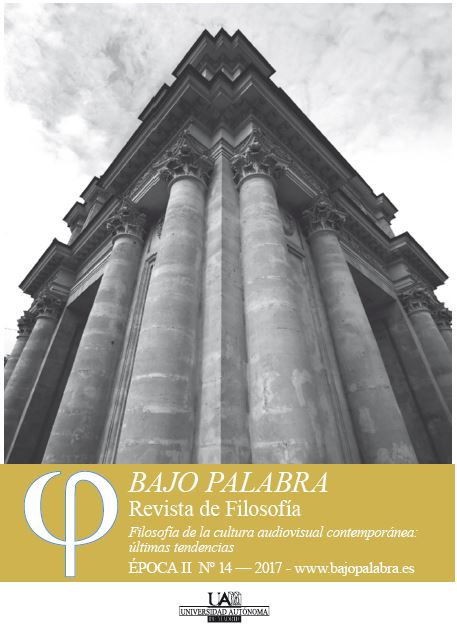Keywords:
Postmodernity, spectator, cyber-spleen, video-clip, spot, Umberto EcoCopyright (c) 2017 Miguel Salmerón Infante

This work is licensed under a Creative Commons Attribution 4.0 International License.
Abstract
This article revisits the difference between the apocalyptic and the integrated, established by Umberto Eco. The first ones consider that mass culture impoverishes and alienates human beings, while the second ones acknowledge its capacity to achieve more democratic and open societies. Our thesis is that the new available media for broadcasting audiovisual productions, especially the Internet, change in such a way the reception of contents that Ecos´s distinction may seem pointless, and thus must be reformulated.
Downloads
References
Baudelaire, Charles, Poesía completa (Edición bilingüe), Barcelona, Río Nuevo, 1974.
Benjamin, Walter, “La obra de arte en la época de su reproductibilidad técnica”, en Obras I/2, Madrid, Abada, 2008, pp. 49-85.
Benjamin, Walter, “Sobre el concepto de historia”, en Obras I/2, Madrid, Abada, 2008, pp. 303-318.
Borges, Jorge Luis, “Del rigor de la ciencia” en Obras Completas, Buenos Aires, Emecé, 1974.
Bozal, Valeriano, Goya. Vida y obra, tomo 2, Madrid, TF Editores 2005.
Briley, Ron, “Sergei Eisenstein: The artist in service of the revolution” en The History Teacher, vol. 29. Number 4, August 1996, pp. 525-536.
Carr, Nicholas, The Shallows. What internet is doing to our Brains, Nueva York, W.W. Norton & Co., 2010.
Carroll, Noëll, Una filosofía del arte de masas, Madrid, Antonio Machado, 2002.
Castro, Fernando, Mierda y catástrofe. Síndromes culturales del arte contemporáneo, Madrid, Fórcola, 2014.
Chion, Michel, La audiovisión. Introducción a un análisis conjunto de la imagen y el sonido, Barcelona, Paidós, 2005.
Conze, Edward (ed.), Buddhist Scriptures, Harmondsworth/ Middlessex/ Baltimore, Penguin Books, 1959.
Deregowski, Jan B.; Parker, Denis M.; Massironi, Manfredo (1994), “The perception of spatial structure with oblique viewing: an explanation for Byzantine perspective?”, en Perception 23 (1), 1994, pp. 5–13. https:/doi.org/10.1068/p230005
Duro, Paul, “Imitation and Authority: the creation of the Academic Canon in French Art 1648-1870” En Anna Bryzinski (ed.) Partisan Canons, Londres y Durham, Duke University Press, 2007, pp.95-113.
Eco, Umberto, La estructura ausente. Introducción a la semiótica, Barcelona, Lumen, 1999.
Eco, Umberto, Apocalípticos e integrados, Barcelona, Lumen, 2011.
Frith, Simon, “The Popular Music Industry”, en Simon Frith/ Will Straw/ John Street (eds.), The Cambridge Companion to Pop and Rock, Cambridge, Cambridge University Press, 2001, pp. 26-52. https:/doi.org/10.1017/ccol9780521553698.004
Gubern, Román, Medios icónicos de masas, Madrid, Historia 16, 1997.
Hadjinicolaou, Nicos, La producción artística frente a sus significados, México, Siglo XXI, 1981.
Jiménez, José, Teoría del arte, Madrid, Tecnos, 2002.
Martín Sánchez, Gonzalo, La música y la evolución de la narración audiovisual. La narración audiovisual en los vídeos musicales, Badajoz, Abecedario, 2010.
McLuhan, Marshall/ Fiore, Quentin, The Medium is the Massage. An inventary of effects, Nueva York, Bantam Books, 1967.
Montiel, Alejandro, Teorías del cine, Barcelona, Montesinos, 1992.
Nietzsche, Friedrich, En torno a la voluntad de poder, Barcelona, Península, 1973.
Ramadzani, Vahhed K., “Writing in pain”, Boundary 2, vol.23. Number 2 (Summer 1996), pp.199-224. https:/doi.org/10.2307/303812
Ramírez, Juan Antonio, Medios de masas e historia del arte, Madrid, Cátedra, 1997.
Rzepi?ska, Maria, “The divine wisdom of Michelangelo in The Creation of Adam”, Artibus et Historiae, vol, 15, number 29, 1994, pp.181-187. https:/doi.org/10.2307/1483492
Sánchez-Navarro, Jordi; Lapaz Castillo, Lola, ¿Cómo analizar un videoclip desde el punto de vista narrativo?, Barcelona, UOC, 2015.
Sedeño Vandellós, Ana María, “El videoclip en el contexto del lenguaje audiovisual”, en Juan Antonio Sánchez López/ Francisco García Gómez (Coords.), Historia, estética eiconografía del videoclip musical, Málaga, Universidad de Málaga, 2009, pp.17-42.
Todd Titon, Jeff, “Labels: identifying categories of blues and gospel”, The Cambridge Companion to Blues and Gospel Music, Cambridge, Cambridge University Press, 2003, pp.13-19. https:/doi.org/10.1017/CCOL9780521806350.003
